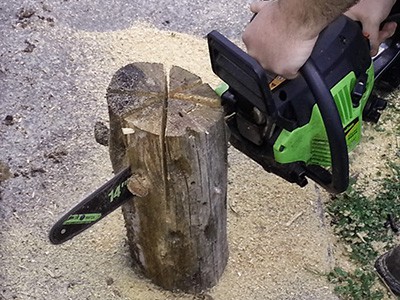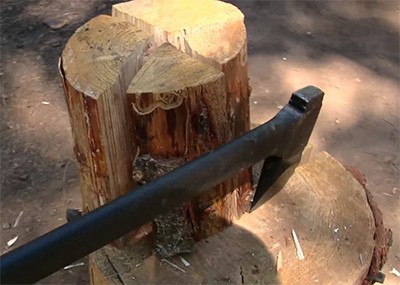Whether you’re looking for an efficient cook fire while camping or looking for something a little different and more for your next backyard campfire, a Swedish fire log may be just what you’re looking for. Also called a Swedish Fire Torch and a Canadian Candle, the history of how this one log fire came to be is vague and seated firmly in romanticized ideals of simpler living, but it serves a very useful and practical design that provides hours of light and heat from just one log and a bit of tinder to get it started.
It’s a simple design and easy to make with either an axe, hatchet, or chainsaw. We’ll look at two different ways to make a Swedish fire log and some of the benefits of Swedish fire log versus a traditional campfire.
Benefits of Swedish Fire Log Over a Campfire

Swedish Fire Log Benefits
Method Process of How to Make a Swedish Fire Log
Safety First
To make a Swedish fire log, you need to be competent with an axe, hatchet, or chainsaw to avoid injury to yourself or bystanders. If you’ve never split wood before, you may want to watch how it’s done before attempting yourself. As with any fire, don’t set it up too close to trees, low hanging branches, buildings, or tents. Never leave a fire unattended.
Chainsaw Method

Materials Needed
Set the log on one end so it is standing vertically. Using the chainsaw, make two or four cuts on the log running about ¾ of its length. This should split the log into sections (as if you were splitting wood) yet leaving the sections attached at the bottom of the log.
Place your kindling atop the log, adding the tinder, too. Light the tinder. As the kindling burns, the log will catch fire at the center where the wood will be the thinnest. It will continue to burn in the center, with the cut spaces allowing for plenty of airflow to keep the fire going.
The very outer edges of the log will not burn, creating a stable surface you can use to cook upon. Those unburned edges also provide protection for your fire from the wind.
As the very bottom of the log won’t burn completely, you are able to carefully move this fire about -should you need to. You can also turn the log upside down, allowing it to burn through the uncut portion of the log.
Axe Method
Materials Needed

This method is very similar to the chainsaw method, however, given the obvious differences in use between the two, this does create a slightly different -but no less efficient- Swedish fire log design.
Split the log into quarters. Shave dry branches into thinner pieces for use as kindling. Arrange the split log pieces on one end, vertically, but with a space between them. They should be in an approximate “log” shape, yet with a good one to two inches gap between the sections. Take your kindling and place it crosswise through the spaces. Alternate the kindling pieces to allow for continuous airflow. This is important, because without enough airflow the log will not catch nor burn and the fire will go out. The kindling should be piled about 2/3 to ¾ of the way up.
Place your tinder atop the kindling and light. As the kindling catches fire, the thinner inside pieces of the log will catch fire. The log will slowly burn from the top down, providing hours of heat and light.
Although this version does split the log into entirely separate sections, this method does still create a stable and flat surface that you can cook upon.
Unlike the chainsaw version, this style of Swedish fire log cannot be moved about or repositioned. This style will burn more thoroughly, also.
How to Make a Swedish Fire Log Conclusion
As you can see, a Swedish fire log is terribly simple to make and allows you to better ration your firewood -which can be crucial when outdoors and wet conditions make it difficult to find enough dry wood to put together a full campfire. The design also provides protection against the elements, which makes this fire log a great addition to your wilderness skill set.
Experimenting with different size logs will give you an idea of how long you can expect the fire to burn, as will using softwood or hardwood. Large tree sized logs can provide a night’s length of light in a dramatic display that is perfect for large family gatherings.